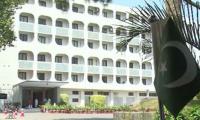LAHORE: Education, health, and research and development (R&D) are three sectors that play a significant role in driving sustainable growth. It is unfortunate that Pakistan lags behind its regional peers, particularly in terms of service delivery in all these sectors.
It is common knowledge that education fosters human capital development, improving skill sets and workforce quality. China allocates around 4.0 per cent of its GDP to education, while India allocated approximately 2.9 per cent of its GDP to education in its 2024 budget. In contrast, Pakistan allocates about 1.7 per cent of its GDP to education, and Bangladesh allocates around 1.8 per cent.
It is surprising that Pakistan is known to have a larger and more vibrant private sector in education than its regional counterparts. However, private schools in Pakistan are often inaccessible to a significant portion of the population due to high fees. India also has a sizable private school sector, but with more diversity in pricing and accessibility.
Furthermore, the quality of education provided at public schools is inadequate. As the private school system is fully entrenched, almost all lucrative vacancies in the public and private sectors go to graduates from private institutions, perpetuating class discrimination. The only solution is to ensure quality education in public-sector organizations.
If reforms are initiated today, it will take a decade for underprivileged children to compete on par with students from private-sector education institutions.Health is crucial for ensuring a productive and efficient workforce, reducing absenteeism and improving life expectancy. The health of human resources is vital for progress across all sectors. Examining health expenditures in China, Pakistan, India and Bangladesh reveals that China is far ahead in this regard; in fact, its health allocations exceed the cumulative allocations of India, Pakistan and Bangladesh combined.
India’s health expenditure is around 2.1 per cent of its GDP, while Pakistan’s is approximately 1.2 per cent. In contrast, China allocates about 5.5 per cent of its GDP to health. A look at health outcomes reveals that Pakistan performs the worst across all indicators. Its infant mortality rate (per 1,000 live births) stands at 55, compared to 27 in India and 24 in Bangladesh.
Average life expectancy is 72.8 years in Bangladesh, 70.8 years in India, and 67.1 years in Pakistan. The maternal mortality rate (per 100,000 live births) is 103 in India, 173 in Bangladesh, and 186 in Pakistan. Child stunting (under five years old) is 28 per cent in Bangladesh, 35.5 per cent in India, and 38 per cent in Pakistan. Anaemia in women aged 15-49 years is 45 per cent in Bangladesh, 52 per cent in Pakistan, and 53 per cent in India.
Public healthcare in Pakistan is often regarded as the most inefficient due to chronic underfunding, poor infrastructure, staff shortages and governance issues. Meanwhile, private healthcare tends to be the most expensive among the three countries, driven by limited public sector alternatives, high out-of-pocket expenses, and unregulated pricing practices, rendering it out of reach for the majority of the population.
Research and development (R&D) drives innovation and enhances productivity and competitiveness. China’s R&D spending of around 2.4 per cent of GDP far exceeds India’s allocation of about 0.7 per cent, with key areas including space, agriculture and technology. In comparison, Pakistan spends around 0.25 per cent of its GDP on R&D, while Bangladesh allocates approximately 0.4 per cent.
India produces around 25,000 PhDs annually, primarily in science and engineering, while Bangladesh produces about 1,000 PhDs per year, mostly in humanities and social sciences. Pakistan produces approximately 2,500 PhDs annually, focusing on natural sciences, engineering and social sciences.
A worker pushes a wheelbarrow to collect cement at a construction site.— Reuters/FileKARACHI: The Sindh Provincial...
Industrialists can ben seen in this picture during a training session be SMEDA on October 23,...
Edible oil bottles can be seen in this image.—Reuters/fileKARACHI: The Pakistan Vanaspati Manufacturers Association ...
Speakers on the stage of "Global Shari’ah Majlis’ hosted by Standard Chatertered Bank at 23 October 2024. —...
A logo of Sibanye Stillwater is seen at a mine in Marikana, outside Rustenburg, northwest of Johannesburg, South...
European Central Bank President Christine Lagarde speaks to reporters following the Governing Council's monetary...







